

 Vol. 39 (Nº27) Year 2018. Page 11
Vol. 39 (Nº27) Year 2018. Page 11
Assel B. BEKBOSYNOVA 1; Galigan R. MADIEV 2; Kulmuhanbet A. AKHMETOV 3; Ukiliai K. KERIMOVA 4
Received: 20/05/2018 • Approved: 08/06/2018
ABSTRACT: The objective of the work is revealing ways and means of cooperatives’ organization in the agricultural sector of the national economy. The research methodology is based on theoretical concepts of economic science and the use of conventional economic research methods. The article elucidates the essence of cooperatives, foreign experience in organization and functioning of cooperative economy, prospective lines of development of cooperatives in agriculture of the Republic of Kazakhstan. The article substantiates the necessity of determining the optimum parameters of the cooperative, as an important condition of its effectiveness, and offers a mathematical and economic model, which is used in solving the problem on defining the optimization structure and size of agricultural production. The creation of cooperatives for processing agricultural products is considered as the priority development direction of agriculture. Accordingly, the article substantiates the ways of their organization, which allow overcoming the monopoly of the large enterprises in this area and the development of joint activities of the related industries. The application of research results in practical work on organization of cooperatives will create conditions for their effective operation. |
RESUMEN: El objetivo del trabajo es revelar formas y medios de organización de las cooperativas en el sector agrícola de la economía nacional. La metodología de investigación se basa en conceptos teóricos de la ciencia económica y el uso de métodos convencionales de investigación económica. El artículo aclara la esencia de las cooperativas, la experiencia extranjera en la organización y el funcionamiento de la economía cooperativa, las líneas prospectivas de desarrollo de las cooperativas en la agricultura de la República de Kazajstán. El artículo corrobora la necesidad de determinar los parámetros óptimos de la cooperativa, como una condición importante de su efectividad, y ofrece un modelo matemático y económico, que se utiliza para resolver el problema de definir la estructura de optimización y el tamaño de la producción agrícola. La creación de cooperativas para el procesamiento de productos agrícolas se considera la dirección de desarrollo prioritaria de la agricultura. En consecuencia, el artículo corrobora las formas de su organización, que permiten superar el monopolio de las grandes empresas en esta área y el desarrollo de actividades conjuntas de las industrias relacionadas. La aplicación de los resultados de la investigación en el trabajo práctico sobre la organización de las cooperativas creará las condiciones para su funcionamiento efectivo. |
In the course of implementing economic reform, large agricultural enterprises have been converted into small farms. This resulted in a fact that small farms and households became the predominant form of economic activity in the country. They account for more than 75% of the agricultural production. Due to their small sizes, manufacture in such farms is based on primitive technology, and as a consequence, the productivity of the used land and animals is low. Improving the production efficiency and increasing the peasants’ and villagers’ income is possible on the basis of their merging into cooperatives (Message of the President of Kazakhstan).
The existing economic ties among the enterprises of agribusiness sectors in the Republic of Kazakhstan were destroyed in the course of economic reform, while sectors involved in agricultural products storage and processing, using their monopolistic position, began to infringe on economic interests of agricultural groups that had led to the increasing disintegration among them. The restoration of an equitable economic relationship is seen currently in the creation of processing cooperatives which will provide equal opportunities to benefit from joint activities.
In accordance with the Law of the Republic of Kazakhstan "On agricultural cooperatives", the scope of activities of cooperatives is not limited. It covers all the activities required to meet the socio-economic and other needs of the cooperative members and protect their interests. The most important of these needs include the agricultural production, products’ storage and processing, distribution of agricultural products and byproducts, aquaculture (fish farming), supply of the means of production and material-technical resources, providing various services to cooperative members, as well as associate members of the cooperative. Agricultural cooperative may be engaged in one or several activities which are reflected in its Charter (Law of the Republic of Kazakhstan No. 372-V ZRK).
The Strategy "Kazakhstan-2050" states that the development of agricultural sector in the country should be based on the formation of large-scale agricultural productions. Practical implementation of this target implies the necessity of cooperative development in the agricultural production sphere. It will allow involving a large part of the self-employed rural population in vigorous activity, enlarging small farms, increasing efficiency of land use and agricultural machinery, and implementing actively innovative technologies (Madiyev and Bekbosynova, 2012).
The present study proves the economic and organizational mechanisms for the development of cooperative forms of management in agrarian sector of Kazakhstan, taking into account its features and specifics.
The research methodology is based on the general provisions of economic science, study of economic processes and phenomena associated with the research objects in their continuous development and change, as well as their close relationship and interdependence. The used economic research methods include scientific abstraction, historical and logical approach, observation and collection of facts, as well as analysis and synthesis. To solve the optimization problem, methods of economic and mathematical modeling were employed.
Driving force of the material production is personal interest, and individual manufacturer’s potential is implemented with the greatest effect in various forms of joint activities. Such unique form of joint activity is cooperative business, which allows individual producers to have an additional benefit from jointly undertaken activities at different stages of the reproduction process (Chayanov, 1925).
Cooperative business is one of the most affordable and versatile forms of business organization in the production development capable of rapid payoff. The advantage of cooperative business is that it is able to create new and more powerful productive force with the same resources, previously used by the individual manufacturer. As a self-governing system, cooperative business most fully corresponds to the market conditions, contributes to the resolution of the contradictions in market relations, softens clashes among opposing economic forces, as well as eliminates hard rubbing and opposing interests in the economic relationship (Akimbekova, 2010).
Cooperative business in the field of agribusiness as a form of interfarm relations includes cooperation of private persons and legal entities engaged in agricultural, industrial, and other economic activities. Participants of such cooperative business may involve different types of farms, including state ones. At that, there is no socialization of individual property, while interfarm cooperation is based on maintaining the legal independence of the cooperative members on the principles of distribution of received revenues and profits (Vakhitov, 2012).
The proportion of small peasant farms and households in agricultural sector is quite high. They should realize the need to unite in cooperatives since joining to cooperative may create favorable environment for solving their numerous problems. These problems concern low level of equipment appliances and agricultural machinery, unavailability of loans to address current problems, including the acquisition of quality seeds, fuel and lubricants, spare parts to repair existing equipment, strengthening fodder recourses for the animals, the timeliness work on the insemination of cows, improvement of breed quality, organization of pastures for animals, and difficulties with sales of manufactured products (Madiyev and Bekbosynova, 2012).
For every farmer and villager, any type of activity is fraught with great difficulties. The natural course of development of independent farming economies has led to the understanding of necessity to merge into cooperatives, the awareness of the efficient use of the benefits of labor division and concentration of amount of work performed. For illustration, here is an example. On the one hand, merging into a cooperative facilitates the purchase of equipment for joint use, while on the other hand, increases the efficiency of applying machinery that results in reduced cost of unit production. Similar results will be achieved by farmers when unifying their efforts in any activities, be it supply material resources to farmers, organization of product storage, drying and additional processing of agricultural products, or products sales, providing services, etc. (Bekbosynova, 2016; Bekbosynova, et. al., 2016).
Cooperative forms of relations among agricultural groups and enterprises in the sphere of agricultural products’ storage and processing are widely used in foreign practice. Economic relations are built on the principles of mutual benefit and equality (Paptsov, 2011; Egorov, 2012; Nechaev and Khatuov, 2010).
In the context of rigid competitive struggle, cooperatives continuously improve production base of owned enterprises through a transition to deep processing of agricultural raw materials on the basis of waste-free technologies. At that, they are very sensitive to consumer demands and market conditions.
Based on the wide use of scientific-technical progress achievements, the cooperatives were able to mobilize their available resources and achieve broad social and government support. They have achieved positive results not only in agriculture but also in agricultural products’ processing, transportation, and distribution (Chepik, 2011).
Agricultural cooperatives in these countries are the most numerous organizational structures that constitute the organic part of non-monopoly sector of the economy. They protect the economic interests of family farms from the expansionism of monopoly capital. Farms are most fully integrated into cooperatives in the Scandinavian countries, Japan, France, and Germany, where cooperatives bring together about 80% of all agricultural enterprises. Moreover, the number of cooperative organizations exceeds the number of farmer economies, because each farmer usually is at the same time a member of two, three, or more different cooperative societies. Conquering the dominant position by cooperatives did not lead to monopoly in pricing. This is prevented by competition and the competitive environment in the national and international markets created by the cooperative groups, which continuously improve their production activities to ensure the successful operation (Ayusheeva, 2013). In the modern structure of agricultural cooperative business, non-productive cooperatives dealing with selling, procurement, credit, and service are most widespread.
In these cooperatives, farmers completely retain their economic independence and responsibility for decision-making. They retain a high pecuniary self-interest in the outcomes of their activities. Through cooperatives, farmers enter the material-technical supply and financial support systems. Cooperatives have significant positions in the field of economic relations between agriculture and related sectors of the economy. Cooperatives play especially significant role in agricultural products’ selling. In the mid 80-ies in the countries of the European Economic Community, the percentage share of cooperatives accounted for 60% of sales of agricultural products, while in Japan this figure exceeded 90% of commercial products of the agricultural sector.
Economic relations between the cooperative and its members are based on the contract system. Each farmer enters into an agreement with cooperative for the period of one or more years. At that, renewable long-term contracts become increasingly widespread. The farmer, who entered into the contract, fulfills all the requirements of the cooperative in terms of production volume, product range, quality, timing schedule, and delivery points. In addition, the farmers must deduct a certain percentage of their annual income to the cooperative for its operational costs. The contracts set a fixed price for a certain product quality. When exceeding quality indicators compared to the contractual ones, bonuses are paid or surcharges are applied to the price (Bekbosynova, et. al., 2016; Madiyev, et. al., 2017).
Despite a variety of forms and methods of contractual relations, the rigidity and certainty of sanctions for violation of the contract terms is the mandatory rule. The strict observance of contractual relations allows the cooperative to provide sustainable economic activities to all member enterprises to achieve high economic efficiency of production.
In contractual agreements, the special attention is paid to product quality as the basis of its competitiveness. For example, low quality milk in comparison with that of the first category is sold at a price three times cheaper. Application of hormones and fishmeal as the animal feed adversely affects the taste of the bacon. Therefore, contractual agreements of the cooperatives with their members for the supply of pigs for slaughter contain a provision, which prohibits the use of such drugs. If the violator of this provision of the agreement is found, it will be immediately excluded from the cooperative. Therefore, each farmer values his membership in the cooperative, which guarantees him the products’ sale, as well as a number of benefits.
It should be noted, that contract agreements include a provision concerning the obligations of the cooperative with respect to its members. If the cooperative has taken ready-to-ship products from the farm not within scheduled time, has violated the terms of the supply of production means or provision of services, etc., that has led to the disruption of the technological process, infringement of production rhythm, etc., then the fine is set in favor of the farmer, who receives not only losses incurred, but also missed profits.
Therefore both parties take a responsible approach to compliance with obligations and commitments stated in the agreement, while breach of contract by both the one and the other party is very rare.
In order to expand the scope of economic activities and the social base of the cooperative sector, in most of Western countries cooperatives expand business relations with producers, who are not cooperative members.
Small, local cooperatives join together into regional cooperative unions, which in turn form major national cooperative associations. Thus, common strategic development issues of the cooperative movement are solved at the national and regional levels. Local cooperatives are engaged in specific tasks peculiar to local area. Possessing large industrial and financial autonomy, including new capital investment, they are able developing any kind of profitable activities (Ayusheeva, 2013; Novikov, 1997).
The current situation in agriculture of the Republic of Kazakhstan suggests the need for large-scale development of production cooperatives. A cooperative of this type is a voluntary association of citizens on the membership basis aimed at joint entrepreneurial activity, and carried out through personal labor participation and association of their member asset contributions; it is a legal entity and refers to the commercial organizations. The factor of personal labor participation of a member (in other words, a member of the cooperative should be employee of this cooperative) distinguishes production cooperative from stock company and economic partnership, where participation is due to the investment of money, and does not require from the cooperative member to be its employee. In other words, the production cooperative is primarily an association of labor, while a business partnership is an association of capital. This predetermines the democratic and popular nature of production cooperatives, which can be created by citizens, who don’t have lots of money, though are able and willing to work.
Production cooperative is entitled to carry out any business activities not prohibited by legislative acts to private enterprise.
In view of the fact that the basis for the agricultural sector development is the formation of effective forms of market actors in agriculture, it is necessary to develop cooperative business in the sphere of agricultural production, which refers to the horizontal type. It will allow involving into active operation a larger part of the self-employed population, enlarging small farms, increasing efficiency of land and technology use, creating conditions for implementation of innovative technologies and quality management.
When unifying into production cooperative, members may render the land, equipment, animals and other means of production. At the same time their owners, who are entering into cooperative, retain ownership of the property delivered to cooperative, including land. The procedures for the use of passed assets and distribution of income among founders are determined by the public meeting, and are enshrined in the Charter, that is a guarantee of equality of all the members of the cooperative, as well as equitable and economically justifiable distribution of income (Moldashev and Akimbekova, 2004).
The variety of natural conditions predetermines the activity directions of production cooperatives. In the northern regions the activity of production cooperatives may cover the production of grain, fodder for livestock, potatoes, vegetables, grain, oilseeds, meat, milk and other agricultural products. In the southern regions, where irrigated agriculture is well developed and there are large areas of natural pastures, the list of activities of production cooperatives can be even much wider. In addition, this region accounts for the majority of small farms, and increasing their production efficiency dictates the necessity of cooperation development on a broad scale. The organization of cooperatives should be based on the relevant law.
Not less important is the organization of products’ distribution. The overcoming of the conflicts of interests between agriculture and processing enterprises through the development of their integration with the provision of the priorities to agricultural producers because of their leading role in the food production cycle is one of the most important ways to stabilize and improve the efficiency of the agricultural sector.
Within the existing circumstances, where influencing the process of aligning the interests between producers and processors by administrative means is impossible, it is advisable to develop contractual relationships between them. According to the agreement, the required production volume, quality of goods, the price level, and the cost of transportation are determined in advance. All this will give the sustainability of each of the parties. Processing enterprises guarantee the sale which is beneficial to the producers that in turn stimulates the assurance of raw materials supply for processors. This improves the capacity utilization ratio and production efficiency of the final product at large (Borobov, 1999).
With the strengthening of production and economic relations in the future, their organizational merger within the cooperative association on a voluntary basis is possible.
In the context of mass organization of cooperatives, an important factor in achieving efficiency in their operations is the determination of the optimal size and sectoral structure of production, ensuring the rational use of resource potential.
When developing models of the production cooperative (PC) we should count the volume of agricultural production, forage, determine the turnover of herd of animals, as well as other indicators (Akhmetov, et. al., 2006; Akhmetov and Asayev, 2014; 2011; Akhmetov, 2017; Otchet o NIR po teme. [Progress report on the research]).
When developing and calculating the optimization parameters of the cooperative, we used simplex procedure of linear programming. The objective of the present work is defining such productive structure of the economy with its limited resources that would ensure the obtaining of maximum profit:
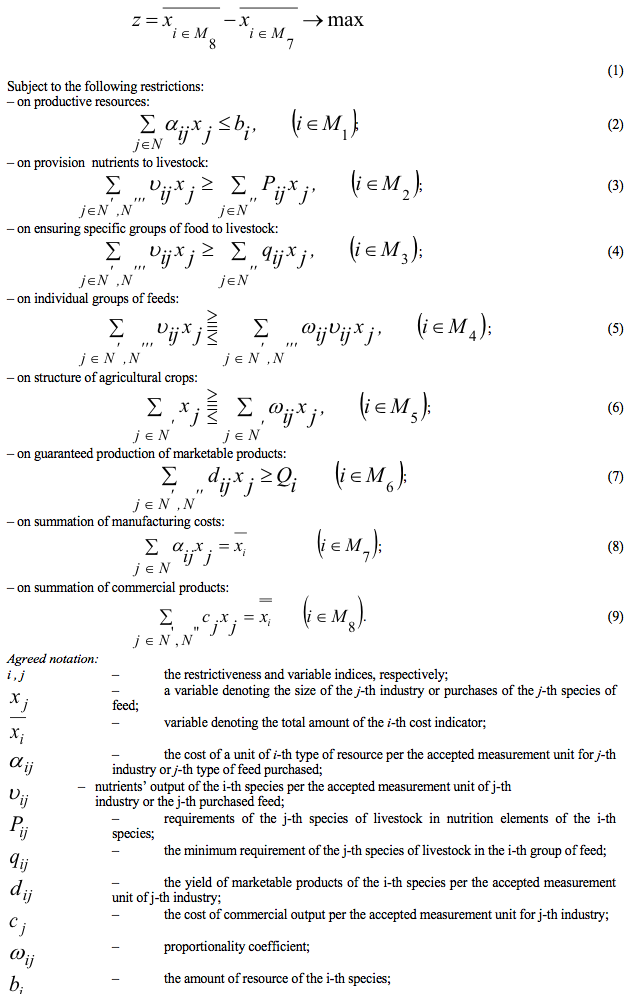

Let consider the standard form of the cooperative for the Republic of Kazakhstan. Structure of commodity output is composed mainly of marketable crop products and livestock. At that, the largest percentage share is made up by wheat. Grain farming is successfully combined with the development of dairy cattle. The average annual cattle population over the recent three years has made up 1453 heads of cattle, including 585 (40.3%) heads of cows, 2248 (66.7%) heads of sheep, including 1500 heads of ewes, 884 heads of pigs, including 200 (22.6%) sows and 78 horses, as well as 21 (26.9%) broodmares. The total area of farmland is 16532 ha, including 606 ha (3.7%) of hayfields, 7789 ha (47.1%) of pastures, and 8118 ha (49.1%) of arable land, among which 2111 ha are irrigated land, or 26.0% of arable land. Suitable arable lands of farms are mostly occupied by grain crops and perennial grasses. The average yield of grain, including grain maize, for 2015-2017 was 16.1 hundred kg per 1 hectare.
The set task is formulated as follows: it is needed to develop economical and mathematical model describing optimal operation of the production system of the cooperative for the Republic of Kazakhstan and determine the optimal production-sectoral structure, the development tendency, resources use and replenishment plan, and the level of production efficiency, provided that products will be sold in amount not less than that in average for previous years, that will ensure maximum efficiency of economic activities according to the chosen optimality criterion.
When developing the expanded economical and mathematical model to optimize the production structure (1)–(9) we prepared necessary background data. To calculate the yield of marketable products and nutrients per unit area, it is necessary to know what part of the product is lost, what proportion is used for the seeds and for the feed. Accordingly were prepared the rest of the background data.
We compiled the following list of variables:
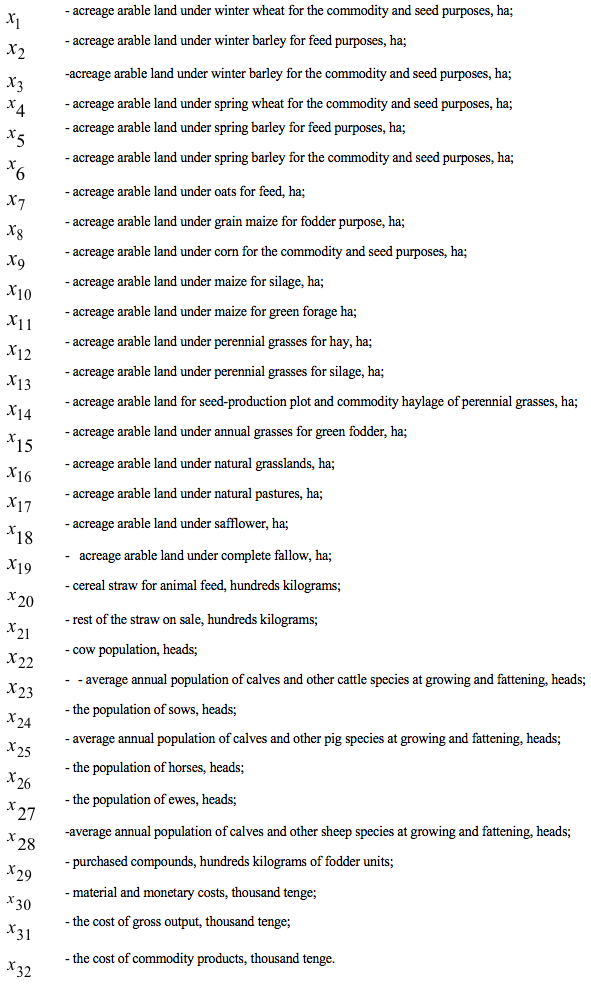
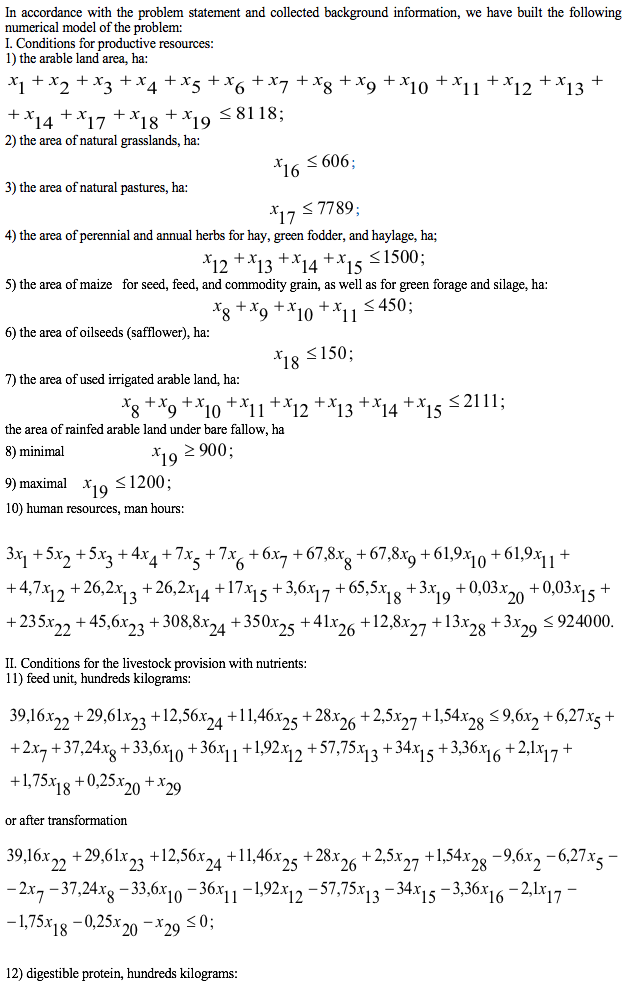
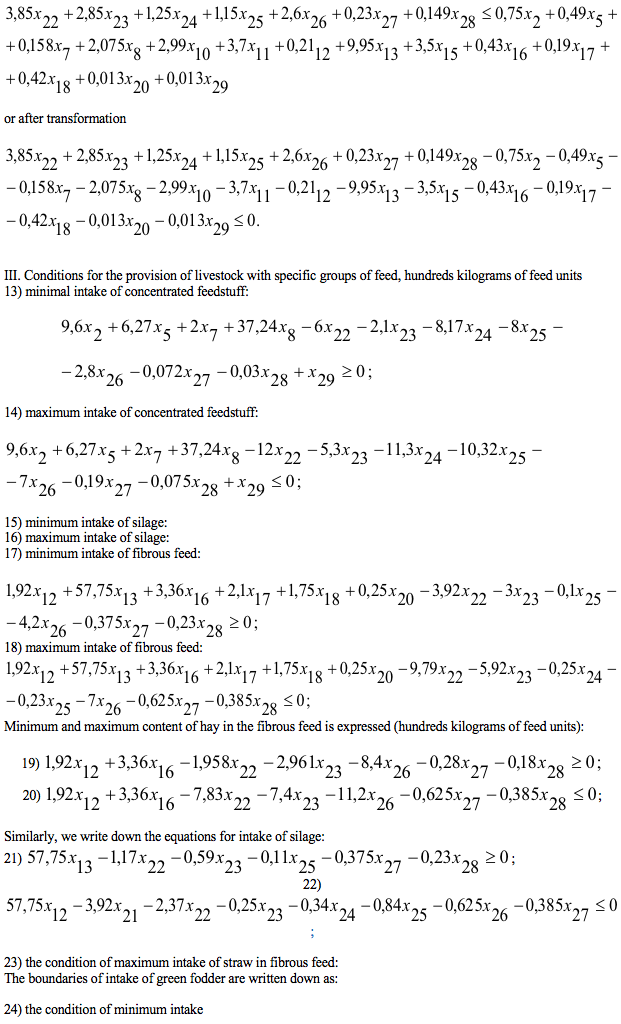
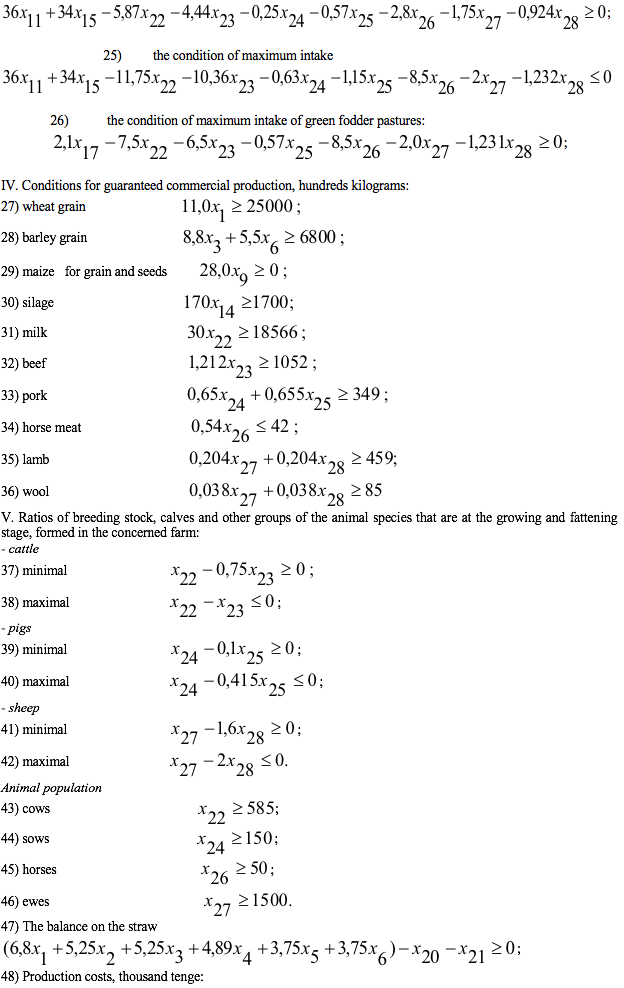
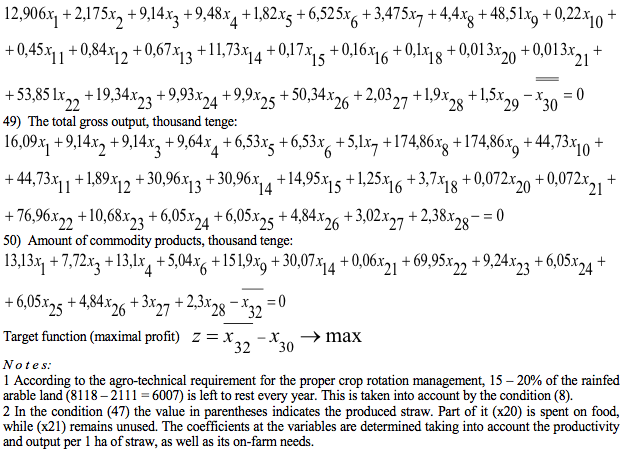
Based on this model, we can consider the variational solution of the problem by introducing additional constraints, as well as changes in the underlying model constraints, for example, the introduction in the right part of the constraints on arable land, area under maize for various purposes, the maximum production of wheat and milk, as well as the increase in the yield of crops including forage, etc.
Optimization results of the production structure of the cooperative. In the first option of the problem solution all the conditions and economy indicators remained unchanged to compare the actual data with the results of the optimal solution, i.e. real economical conditions were simulated.
The task was solved on the computer using the application software package. The obtained values of the variables are given in the table1.
Table 1
Results of the solution
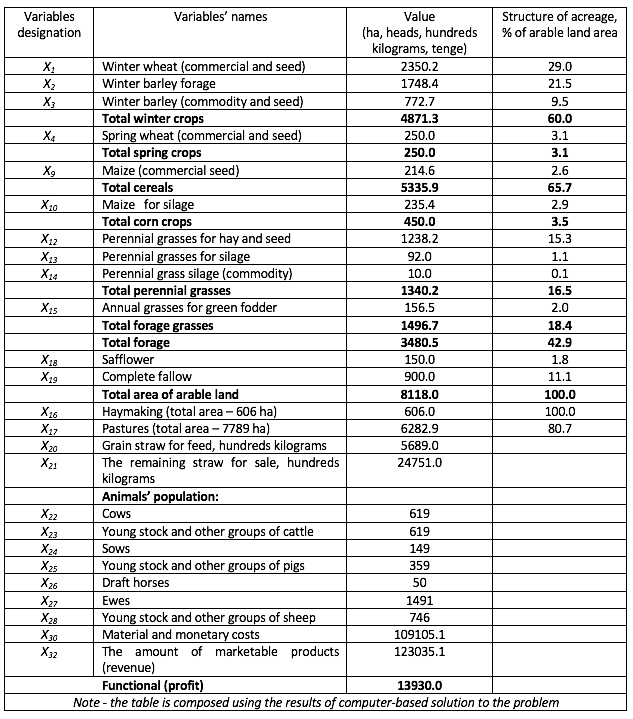
In consequence of the problem solution, we determined by the size of cultivated areas by crops and livestock population by species. Despite the development of dairy cattle, the structure of sown areas is characterized by high proportion of cereals (65.7%), including winter crops (60.0%). Provision of feed rations by feed units and digestible protein demanded large areas of winter feed barley, the proportion of which accounted for 21.5% of the arable land area.
The proportion of fodder crops in the sown areas structure accounted for 42.9%, including 2.9% on corn silage, 16.5% on perennial grasses (15.3% on hay and 1.1% on silage), and 2.0% on annual grasses for green fodder. The proportion of technical crops, such as safflower, accounted for 1.8% of arable land, and its sown area was determined just to satisfy the alleged sale plan.
Compared to other crops, spring cereals were less effective. The proportion of spring wheat accounted for 3.1% of the arable land, which was determined only at the level of intrafarm needs.
A high proportion of cereals and a relatively low proportion of forage at the developed dairy cattle breeding resulted from effective use of feed resources including maximum use of natural pasture grasses (80.7% of the total area), which provided cattle with cheap green forage during the entire grazing period.
Comparative indicators of industrial structure of the cooperative are shown in Table 2.
Table 2
Comparative indicators of the cooperative's production structure
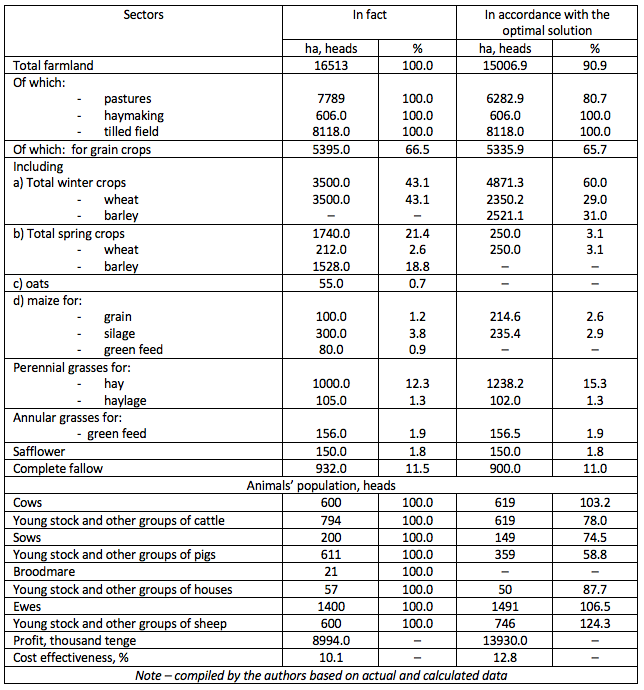
In the optimal plan, the leading branch of the economy was given to dairy cattle breeding, which amounted to 1238 heads that by 156 heads was less than the actual number (which was 1394 heads), including 619 cows, that was by 19 heads greater than the actual number. Such structural change in cattle farming was due to the reduction by 175 heads in the average annual population of calves and other groups of cattle that showed the unprofitability of beef production.
Pig, horse and sheep breeding sectors, mainly organized to meet on-farm needs, are characterized by different efficiency that shows the level of their structural changes (Table 2). The rational use of pasture forage allowed developing effectively sheep-breeding, which was determined in the amount of 2237 heads that by 237 heads was greater than the actual number, including the number of ewes, which had increased by 91 heads.
No substantial change had occurred in the fodder crops’ structure (Table 2), with the exception of maize for green forage, which was not effective. The grain structure was changed as well. For example, the proportion of winter crops amounted to 60% of arable land against the actual value of 43.1%, while that of spring crops, on the contrary, decreased to 3.1% against the actual proportion of 21.4%.
Milk production should be combined with commodity grain and feeding root crops. However, the cooperative is not engaged in the production of feeding root crops (Table 2). The proportion of cattle in commercial products according to the optimal solution had changed slightly (from 38.4 to 39.8%, including milk – from 32.8 to 35.2%).
In the commodity products’ structure, the proportion of corn grain had increased from 10.6 to 18.0%, while no significant changes were revealed in the crop farming. Although there was a tendency of reduction of crop production commodity from 54.5 to 52.5% that could not be seen based on monetary expression of crop production commodity, which actually made up 53219,5 thousand tenge against the optimal solution of 64512,3 thousand tenge. Hence the direction of production specialization is clearly seen, that requires the search for another combination of industries under given land conditions.
The obtained solution meets all the requirements posed in the set problem. Arable land in the farm is fully utilized, provided by the development of a balanced crop rotation due to the annual allocation of 900 ha of the total arable land for complete fallow. Non-irrigated arable land is fully utilized, while labor demand does not exceed available resources (more than half of the labor force, specifically 471291 man hours, remain unused).
The world practice of agro-industrial complex functioning has shown that the activities related to the provision of food have gone beyond agriculture and form now a single, tightly integrated system of interdependent industries, in which agriculture, processing industry, storage and refrigeration sector, enterprises of wholesale and retail trade interact on an equal footing.
System, in which agriculture is integrated with related industries, is called agribusiness, which is based on agriculture because its development determines the efficiency of other partners in the joint activities of related industries. The effectiveness of such integration is obvious. It exempts rural producers from a variety of concerns for products’ storage and distribution, as well as from searching for the necessary material resources that is more efficiently performed by specialized divisions. It creates conditions for the development of non-waste technology, diversification of production, and ultimately maximizes profits of each of the cooperative members (Bekbosynova, 2005; Starchenko, 2003).
The current situation in agricultural industry in Kazakhstan is not consistent with international practice.
Monopolistic tendencies of the processing enterprises and the establishment of unilaterally favorable prices led to increased disintegration with their agricultural producers. As a result the production performance of farms every year is getting worse.
The creation of processing cooperatives could become one of the priority directions in the development of economically profitable conditions for both parties. Such cooperatives must be based on economic relations, which will provide equal opportunities to benefit from joint activities, effective development of resource base of the processing industry. The main document which underlies the relationship of the supplying farms and processors is a contract, which preserves the legal status and autonomy of each of the economic entities (Ayusheeva, 2013).
Economic relations among these entities are built on the principle of collegiate decision-making on issues concerning prices of agricultural products supplied to processing, as well as finished products. At the same time the cooperative determines the supply volume of agricultural products for processing, and prepayment for the products. The delivery of agricultural products from producers to processing enterprises is carried out at the rates set by the general meeting of the cooperative members. The obtained profit should be distributed among the members-shareholders in accordance with their individual contribution to the overall result. This contribution is determined based on the participatory interest of each member in the total volume of delivery of the products for processing.
If the cooperative is created directly on the funds of commodity producers, and processing enterprise is the property, then it is possible using another method to determine the interest of the cooperative members in the end result. At that, along with the amount of supply of agricultural products for processing, the size of equity contributions to the statutory fund should be additionally taken into account. In this case, the following proportions should be met: two-thirds of the net income are distributed depending on the agricultural products’ volume supplied for processing, while one third is distributed depending on size of the participatory interest. This method stimulates in shareholders the desire to increase agricultural production (Chepik, 2011).
Cooperatives also organize the processing and distribution of specialized products sold not only in domestic but also in foreign markets. For example, the share of cooperatives in Portugal, France, and Italy accounts for 30-40% of the wine production and sales in the world market. Cooperatives control most of the food industry or its individual sectors. The cooperative sector in the Nordic countries provides up to 50% of the total volume of the food industry. A high proportion of cooperatives in merchandising of agricultural products is to some extent due to the fact that products produced by farmers and taken into account by current statistics as marketed (i.e. going beyond the agricultural sector) are usually supplied to the processing enterprises owned by cooperatives. There are cooperatives that are fully engaged in the milk processing. Their dairy factories produce most of the butter and cheese, variety of other dairy products in line with demand in both domestic and foreign markets (Novikov, 1997).
Depending on the industry sectors and their activities, the organization of primary cooperatives for processing of agricultural products has the following features.
The economic irrationality of the existence of small grain reception centers and processing enterprises in the district and administrative centers or in close proximity to them, encourages them to establish contractual relations with agricultural producers, preserving the legal status and autonomy of each of the business entities. This reduces the risk for both producer and processor. The contract determines the level of prices, income, output, quality, and transportation cost. In the future, with the consolidation of production and economic relations, their institutional merger will be possible within the cooperative association on a voluntary basis.
Organizational and economic conditions of any area in the Northern region allow organizing a cooperative for the grain storage and processing. To justify the optimum capacity parameter of the grain elevator, it is necessary to determine the prospects for grain production.
Small capacity enterprises for meat and milk processing created in recent years in the households have led to water pollution due to lack of treatment facilities. Besides, the lack of laboratory quality control of raw materials and finished products, a large percentage of losses and many other deficiencies did not allow meeting the demand of buyers for produced products.
One way to solve this problem is to create joint cooperative of agricultural enterprises at district level. This cooperative may include the agricultural enterprises of different forms of ownership and management. At that, unification is implemented not in all spheres of their activities. Here, the cooperative performs only the functions that are voluntarily given by founders. The cooperative is not higher-level agency with respect to its affiliated independent enterprises. The overall management of the cooperative is carried out by general meeting, while operational administration is undertaken by its chairman, who is accountable to the general meeting of the cooperative.
Functions of the cooperative include the organization of milk or cattle purchase, conducting quality analysis, transportation, processing and sales of finished products, and payments to partners. In addition, the cooperative provides veterinary care, artificial insemination, as well as provides methodological and advisory assistance.
The organizational structure of the cooperative consists of the following services: marketing, logistics, veterinary, advisory, etc. All the enterprises included in the cooperative, have full economic independence, while the output is the property of the producers up to the products’ sales stage. The cooperative operates in the following manner: milk is delivered to the plant by producers or collected by the cooperative itself, after that the products are checked for quality, accepted and documented by the relevant documents. The amount owed to the producer is recorded on his settlement account in the accounting department of the cooperative.
The task of the integrated structure is to level the profitability of its participants. The share contribution of each participant of integration into final result of the integrated association is considered to be the criterion of equal profitability in exchange relations.
In general, it should be noted that the best practices of foreign countries in cooperative business for all its importance cannot be mechanically transferred to our current conditions. Nevertheless, at critical analysis this experience is of great value for theoretical generalizations, the formation of a coherent scientific concept, and the legal framework of agricultural cooperative business at market relations.
The results of studies on the development of cooperation in the agricultural sector were presented and discussed at the scientific-technical council of the Research and Consulting Institute of Agribusiness at Kazakh National Agrarian University. Council members gave the research appreciation noting specifically some positive aspects such as strict adherence to the provisions of economic science, and the principles of systemic approach to the problem. It was also noted that the generalizations were based on the results of analysis and solution to the problem of optimizing the size and industrial structure of production.
The research was carried out in the framework of grant financing of the project No. 5467/GF4 "Developing the theoretical basis and economic mechanisms to form macroeconomic environment as the basis of industrial-innovative development of the agribusiness of the Republic of Kazakhstan ", the state registration No. 0115RK01913. The development of cooperation in agrarian sector of economy will allow eliminating the existing negative factors in the industry, improving the efficiency of use of resource potential, giving opportunity to market actors to sell their products at prices prevailing in the agricultural product markets. It will allow also creating the economic conditions for the organization of the innovation based reproduction process. Cooperative members retain ownership of the property passed to the cooperative, while the economic relations between the cooperative and its members must be based on a contract system that ensures the equality of all members, as well as equitable and economically viable distribution of income.
The priority way to move forward in agriculture should be based first of all on creation of production and processing cooperatives.
We express our sincere gratitude to all the project executors for joint efforts in conducting the research project in general, and the development of cooperation in agriculture, in particular, as well as carrying out studies on the substantiation of optimal parameters.
Message of the President of Kazakhstan. Leader of the Nation Nursultan Nazarbayev to people of Kazakhstan "Strategy Kazakhstan-2050: New line of policy of the successful state". Kazahstanskaja Pravda [The Kazakh Truth] 18.01.2014, No. 11 (27632).
Law of the Republic of Kazakhstan No. 372-V ZRK "On agricultural cooperatives" of 29.10.2015. Kazahstanskaja Pravda [The Kazakh Truth] 31.10.2015, No. 209 (28085).
Madiyev, G.R. and Bekbosynova, A.B. (2012). Rekomendacii po organizacii kooperativov v sel'skom hozyajstve [Recommendations on the organization of cooperatives in agriculture]. Almaty: Aitumar, pp. 17.
Chayanov, A.V. (1925). Kratkij kurs kooperacii [A short course of cooperation]. Moscow: Central Partnership "Cooperative Publisher", pp. 8-9.
Akimbekova, G.U. (2010). Sel'skohozjajstvennaja kooperacija v Respublike Kazahstan: problemy i puti reshenija [Agricultural cooperation in Kazakhstan and the ways of solution]. Ekonomіka APK : mіzhnar. nauk.-virob. Zhurn, 9, 161-166.
Vakhitov, K.I. (2012). Kooperaciya: teoriya, istoriya, praktika [Cooperation: Theory, history, and practice], 6th edition. Moscow: Publishing and trading corporation "Dashkov and Co.", pp. 560.
Bekbosynova, A.B. (2016). Ravitie kooperacii vertikal'nogo tipa v agrarnom sektore RK [Development of vertical cooperation in the agricultural sector of Kazakhstan] (pp. 29-32). Proceedings of the XIIIth International research-to-practice conference "Problems of economy, organization and management in Russia and abroad", World Press, Prague.
Bekbosynova, A.B., Esengazieva, S.K. and Madiyev, G.R. (2016). Ehkonomicheskie metody stimulirovaniya razvitiya kooperacii [Economic incentives for the development of cooperative business] (pp. 32-37). Proceedings of the XIIIth International research-to-practice conference "Problems of economy, organization and management in Russia and abroad", World Press, Prague.
Paptsov, A.G. (2011). Sel'skohozyajstvennaya kooperaciya za rubezhom//Sostoyanie i perspektivy razvitiya kooperacii v agrarnom sektore ehkonomiki [Agricultural cooperation abroad: State and development prospects of cooperation in the agricultural sector of the economy]. Moscow: LLC "NIPKC Voskhod-A", pp. 135.
Egorov, V. (2012). Mirovoj opyt razvitiya kooperacii v sel'skom hozyajstve [Global experience in development of cooperation in agriculture]. AIC: Economy and Management, 1, 87-94.
Nechaev, V.I. and Khatuov, D.Kh. (2010). Sovershenstvovanie sistemy gosudarstvennogo regulirovaniya regional'noj ehkonomiki: monografiya [Improving the system of state regulation of regional economy]. Krasnodar: Kuban State Agrarian University, pp. 139.
Chepik, O.V. (2011). Nekotorye ehkonomicheskie aspekty gosudarstvennogo regulirovaniya i podderzhki sel'skohozyajstvennyh tovaroproizvoditelej [Some economic aspects of state regulation and support of agricultural producers]. Bulletin of Rostov State Economic University, 35, 79-87.
Ayusheeva, A.O. (2013). Formirovanie integrirovannyh struktur agropromyshlennogo kompleksa regiona: problemy i perspektivy: monografiya [Formation of the integrated structures of the agro-industrial complex in the region: Problems and prospects: Monograph]. Novosibirsk: CRNS Publishing House, pp. 153.
Madiyev, G.R., Kerimova, U.K., Esengazieva, S.K. and Bekbosynova, A.B. (2017). Rekomendacii po razvitiyu ehkonomicheskih vzaimootnoshenij mezhdu predpriyatiyami smezhnyh otraslej APK RK [Recommendations for the economic relations development between enterprises of related industries in agribusiness of Kazakhstan]. Almaty: Gylym Ordasy, pp. 29.
Novikov, V.N. (1997). O razvitii integracii i kooperacii v agropromyshlennom komplekse [On the development of integration and cooperation in agro-industrial complex]. Economics of Agricultural and Processing Enterprises, 4, 15-18.
Moldashev, A.B. and Akimbekova, G.U. (2004). Problemy razvitiya kooperacii i integracii v APK Kazahstana [Problems of cooperation development and integration into agribusiness of Kazakhstan]. Scientific Bulletin of Seifullin Akmola University, Astana, 3.
Borobov, V.N. (1999). Sistema kooperacii - ehffektivnoe sredstvo vosstanovleniya i razvitiya mezhkhozyajstvennyh svyazej APK [Cooperation system: An effective means of reconstruction and development of interfarm linkages in agriculture]. Agricultural and Processing Enterprises Economy, 2, 42-44.
Akhmetov, K.A., Asayev, R.A. and Akhmetova, G.K. (2006). Metodologicheskie osnovy sozdaniya paketa programm "ARM – prognozist" [Methodological aspects of creating a software package "ARM – Forecaster". Statistics, Accounting and Auditing, 2, 23-27.
Akhmetov, K.A. and Asayev, R.A. (2014). Prinyatie upravlencheskih reshenij na komp'yutere [Computer based managerial decision making]. Tutorial, Almaty: "Bastau" Publishing House, pp. 391.
Akhmetov, K.A. and Asayev, R.A. (2011). Algoritm postroeniya prognoza ob"ema realizacii sel'skohozyajstvennyh produktov s sezonnym harakterom prodazh [Forecast constructing algorithm for sales volume of agricultural products with the seasonal nature of sales]. KazNAU, Studies and Results of KazNAU, Almaty, "Agrouniversity", 4, 126-133.
Akhmetov, K.A. (2017). Ocenka kachestva prognozirovaniya osnovnyh pokazatelej sel'skogo hozyajstva Respubliki Kazahstan [Quality evaluation of the basic agricultural indicators forecasting in the Republic of Kazakhstan] (pp. 40-47). Proceedings of the 10th International scientific conference, Journal of Economic Science, "Beneficiary", Kemerovo: "Pluton" Publishing House. Retrieved from http://beneficiar-idp.ru/wp-content/uploads/k10.pdf
Otchet o NIR po teme. [Progress report on the research: "Developing theoretical basis and economic mechanisms to form macroeconomic environment as the industrial-innovative development basis of the agribusiness of the Republic of Kazakhstan"]. (2017). The state registration No. 0115RK01913, Almaty, pp. 299.
Bekbosynova, A.B. (2005). Razvitie integracii i kooperacii v pererabotke sel'skohozyajstvennoj produkcii [Development of integration and cooperation in the agricultural products processing] (pp. 77-79). Collection of materials devoted to the 75th Anniversary of Kazakh National Agrarian University "Stabilization and development strategy of agro-industrial complex of Kazakhstan in the context of economy globalization"], Kazakh National Agrarian University, "Agrouniversity", Almaty.
Starchenko, V.M. (2003). Kollektivnye formy hozyajstvovaniya v sisteme mnogoukladnoj ehkonomiki APK [Collective forms of management in the system of a mixed agribusiness economy]. Moscow: Agroprogress, pp. 272.
This article uses research results obtained in the frameworks of grant funding No. 5467/GF4, registration No. 0115РК01913, carried out in Kazakh National Agrarian University (Almaty, Kazakhstan).
1. International University of Kyrgyzstan, 17A/1, St. Tolstoy, Bishkek, 720007, The Kyrgyz Republic, E-mail: kaznau.nikia@mail.ru
2. Kazakh National Agrarian University, 8, Abay Ave., Almaty, 050010, Republic of Kazakhstan
3. Kazakh National Agrarian University, 8, Abay Ave., Almaty, 050010, Republic of Kazakhstan
4. Kazakh National Agrarian University, 8, Abay Ave., Almaty, 050010, Republic of Kazakhstan